

Smith and Wesson Model 41 Target Pistol Maintenance
Basic Field Stripping and Reassembly
Click image to enlarge picture


Slide Detailed Disassembly and Reassembly
Click image to enlarge picture


Click image to enlarge picture


Extractor Tuning Adjustment Procedure
Click image to enlarge picture
Step #1 |
This procedure was first developed to help reduce S&W Model 41 ejection problems by the late pistolsmith Austin Behlert. Remove the slide from the pistol by field stripping. Test the extractor’s holding capability by placing a round under the hook on flush on the bolt face. Gently shake the slide back and forth. If the case falls off, then the extractor is not to holding the cases securely against the bolt face. The extractor can be tuned by using the following steps. |
|
Step #2 |
Remove the extractor hook from the bolt assembly by following the slide disassembly directions above. | |
Step #3 |
Place the extractor hook in a drill press vise. Tighten the vise jaws down just enough to put a slight bend (or bow) in the back side of the extractor hook – a few thousandths of an inch is all you’re trying to accomplish by this process. Caution – over tightening the vise jaws will break the M-41 extractor! | |
Step #4 |
Use a pointed pin punch and tap it lightly with a hammer, in a stippling action, to make small dimples along the back side of the extractor. These dimples relieve the strain on the hardened steel and allow the extractor to conform to the new shape without having to re-heat treat it. | |
Step #5 |
Next lightly file the roughened dimples to smooth out the extractor’s surface. Filing the extractor surface allows it to move smoothly when inside the slide’s extractor slot. Re-blue the extractor after filing and replace it in the bolt. | |
Step #6 |
Retest the newly tightened extractor hook by the round placement method. | |
Step #7 |
Reinstall the slide onto the pistol. Extractor tuning adjustment is complete. Time to go out and live fire the pistol to test extractor operation. |


Magazine Disconnector Operation
| The trigger bar is forced downwards by the magazine disconnector lever when a magazine in not installed. The magazine disconnector lever is spring loaded to push downwards. When the trigger bar is down the sear is disengaged, and the hammer cannot be released by an operator pulling the trigger. The top (curved shark fin) portion of the trigger bar also has a disconnector function. When the slide is out of battery the fin is forced downward by the slide, this disconnects the sear and prevents the pistol from being discharged. |
| The trigger bar is forced upwards when a magazine is installed. The magazine disconnector lever is pushed upwards by the trigger bar return spring. When the trigger bar is up, the sear is now engaged by it and the hammer can be released by an operator pulling the trigger. The top (curved shark fin) portion of the trigger bar is now aligned with the cut-out recess in the slide. When the slide is closed it's in battery, this allows the sear to be engaged by the trigger bar and the pistol can be discharged. |
Copyright © Bullseye 2006 - 2013, Guntalk-Online.com, All rights reserved


